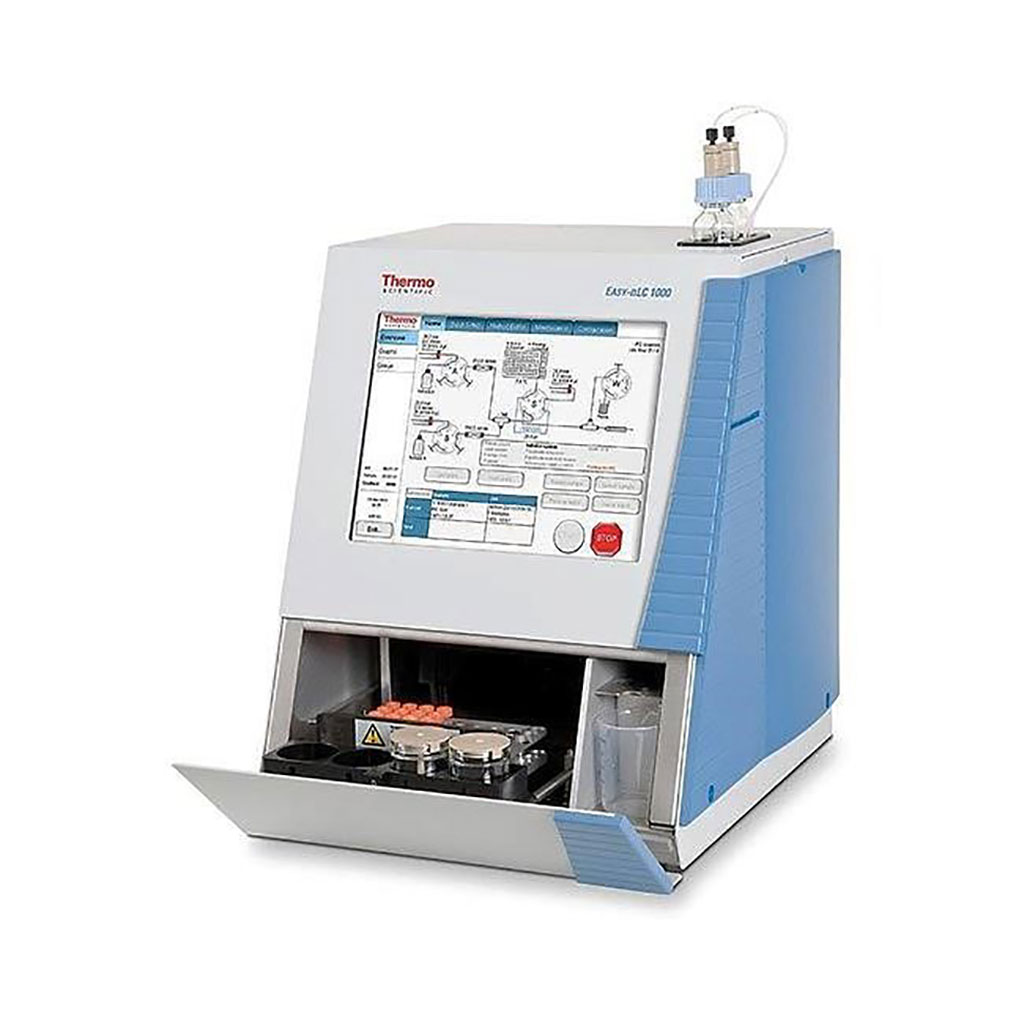Blood-Based Biomarker Predicts Onset of Symptomatic Alzheimer’s Disease
|
By LabMedica International staff writers Posted on 16 Sep 2021 |

Image: The EASY-nLC 1000 HPLC system is s a fully integrated, split-free, nanoflow liquid chromatograph optimized for separating biomolecules such as proteins and peptides (Photo courtesy of Thermo Fisher Scientific)
Alzheimer’s disease (AD) is a progressive neurodegenerative disorder, starting with a preclinical phase of normal cognition lasting approximately two decades. The formal diagnosis of AD dementia, relies on neuropsychological tests further confirmed by brain imaging and cerebrospinal fluid (CSF) sampling.
The pathogenic features of AD that have an onset in the preclinical phase may allow identification of such early blood-based biomarkers. By eliciting compensatory responses, these early pathogenic changes were found to initially prevent the increase in reactive oxygen and nitrogen species (ROS/RNS) through activation of antioxidant mechanisms.
Scientists at the University of Brescia (Brescia, Italy) and their colleagues collected blood samples from 482 subjects aged between 60 and 85 years who did not present specific comorbidities (uncontrolled diabetes, vascular disease, severe depression, or psychiatric illnesses) and were included in a retrospective study collecting a total of 515 blood samples from the Australian Imaging, Biomarkers and Lifestyle (AIBL) study by applying a consecutive sampling approach.
The team performed immunoprecipitation (IP) followed by liquid chromatography (LC) tandem mass spectrometry (MS/MS) and protein sequencing in plasma samples from the AIBL study identified the clinically relevant AZ 284 peptide (AlzoSure Predict test, Diadem, Brescia, Italy), representing a measure of the U-p53 conformational variant (U-p53AZ). Based on U-p53AZ quantification via IP/LC electrospray ionization-coupled MS/MS (Thermo Scientific EASY-nLC 1000 HPLC system, coupled to a Thermo Fisher Scientific EASYSpray source, Waltham MA, USA), supported by an analytical nanoflow column system. The predictive performance of U-p53AZ was assessed and compared with amyloid load as measured by amyloid β-positron emission tomography (Aβ-PET). Its predictive performance was determined at 36, 54, 72 and 90 months.
The investigators reported that U-p53AZ was able to identify individuals with AD dementia with an area under the receiver operating characteristic curve (AUC) of 99%. U-p53AZ outperformed the conventional Aβ-PET measures in predicting the onset of AD dementia both from preclinical (AUC=98%) and prodromal stages (AUC=89%), even 90 months prior to onset (AUC=99%). Additionally, the estimated predictive performance of U-p53AZ was superior (AUC ≥98%) to other risk factors (i.e., gender, Aβ-PET and APOE ε4 allele status) in identifying individuals at high risk for progression to AD.
The authors concluded that their findings support use of U-p53AZ as blood-based biomarker predicting if individuals, at both asymptomatic and MCI stages, would progress to AD at least six years prior to the onset of clinical AD dementia. The study was published on August 25, 2021 in the journal medRxiv.
Related Links:
University of Brescia
Diadem
Thermo Fisher Scientific
The pathogenic features of AD that have an onset in the preclinical phase may allow identification of such early blood-based biomarkers. By eliciting compensatory responses, these early pathogenic changes were found to initially prevent the increase in reactive oxygen and nitrogen species (ROS/RNS) through activation of antioxidant mechanisms.
Scientists at the University of Brescia (Brescia, Italy) and their colleagues collected blood samples from 482 subjects aged between 60 and 85 years who did not present specific comorbidities (uncontrolled diabetes, vascular disease, severe depression, or psychiatric illnesses) and were included in a retrospective study collecting a total of 515 blood samples from the Australian Imaging, Biomarkers and Lifestyle (AIBL) study by applying a consecutive sampling approach.
The team performed immunoprecipitation (IP) followed by liquid chromatography (LC) tandem mass spectrometry (MS/MS) and protein sequencing in plasma samples from the AIBL study identified the clinically relevant AZ 284 peptide (AlzoSure Predict test, Diadem, Brescia, Italy), representing a measure of the U-p53 conformational variant (U-p53AZ). Based on U-p53AZ quantification via IP/LC electrospray ionization-coupled MS/MS (Thermo Scientific EASY-nLC 1000 HPLC system, coupled to a Thermo Fisher Scientific EASYSpray source, Waltham MA, USA), supported by an analytical nanoflow column system. The predictive performance of U-p53AZ was assessed and compared with amyloid load as measured by amyloid β-positron emission tomography (Aβ-PET). Its predictive performance was determined at 36, 54, 72 and 90 months.
The investigators reported that U-p53AZ was able to identify individuals with AD dementia with an area under the receiver operating characteristic curve (AUC) of 99%. U-p53AZ outperformed the conventional Aβ-PET measures in predicting the onset of AD dementia both from preclinical (AUC=98%) and prodromal stages (AUC=89%), even 90 months prior to onset (AUC=99%). Additionally, the estimated predictive performance of U-p53AZ was superior (AUC ≥98%) to other risk factors (i.e., gender, Aβ-PET and APOE ε4 allele status) in identifying individuals at high risk for progression to AD.
The authors concluded that their findings support use of U-p53AZ as blood-based biomarker predicting if individuals, at both asymptomatic and MCI stages, would progress to AD at least six years prior to the onset of clinical AD dementia. The study was published on August 25, 2021 in the journal medRxiv.
Related Links:
University of Brescia
Diadem
Thermo Fisher Scientific
Latest Technology News
- Machine Learning Models Diagnose ALS Earlier Through Blood Biomarkers
- Artificial Intelligence Model Could Accelerate Rare Disease Diagnosis
- AI Saliva Sensor Enables Early Detection of Head and Neck Cancer
- AI-Powered Biosensor Technology to Enable Breath Test for Lung Cancer Detection
- AI Model Achieves Breakthrough Accuracy in Ovarian Cancer Detection
- Portable Biosensor Diagnoses Psychiatric Disorders Using Saliva Samples
- Cell-Sorting Device Uses Electromagnetic Levitation to Precisely Direct Cell Movement

- Embedded GPU Platform Enables Rapid Blood Profiling for POC Diagnostics
- Viral Biosensor Test Simultaneously Detects Hepatitis and HIV
- Acoustofluidic Device to Transform Point-Of-Care sEV-Based Diagnostics
- AI Algorithm Assesses Progressive Decline in Kidney Function
Channels
Molecular Diagnostics
view channel
New 15-Minute Hepatitis C Test Paves Way for Same-Day Treatment
Chronic hepatitis C infection affects an estimated 50 million people worldwide and causes around 242,000 deaths each year, largely due to cirrhosis and liver cancer. Although the infection is curable with... Read more
Ovarian Cancer Assay Outperforms Traditional Tests in Early Disease Detection
Globally, ovarian cancer is one of the deadliest cancers affecting women. Traditionally, early diagnosis of ovarian cancer has been challenging. Many ovarian cancers are diagnosed only after they have... Read moreHematology
view channel
MRD Tests Could Predict Survival in Leukemia Patients
Acute myeloid leukemia is an aggressive blood cancer that disrupts normal blood cell production and often relapses even after intensive treatment. Clinicians currently lack early, reliable markers to predict... Read more
Platelet Activity Blood Test in Middle Age Could Identify Early Alzheimer’s Risk
Early detection of Alzheimer’s disease remains one of the biggest unmet needs in neurology, particularly because the biological changes underlying the disorder begin decades before memory symptoms appear.... Read more
Microvesicles Measurement Could Detect Vascular Injury in Sickle Cell Disease Patients
Assessing disease severity in sickle cell disease (SCD) remains challenging, especially when trying to predict hemolysis, vascular injury, and risk of complications such as vaso-occlusive crises.... Read more
ADLM’s New Coagulation Testing Guidance to Improve Care for Patients on Blood Thinners
Direct oral anticoagulants (DOACs) are one of the most common types of blood thinners. Patients take them to prevent a host of complications that could arise from blood clotting, including stroke, deep... Read moreImmunology
view channel
Routine Blood Test Can Predict Who Benefits Most from CAR T-Cell Therapy
CAR T-cell therapy has transformed treatment for patients with relapsed or treatment-resistant non-Hodgkin lymphoma, but many patients eventually relapse despite an initial response. Clinicians currently... Read more
New Test Distinguishes Vaccine-Induced False Positives from Active HIV Infection
Since HIV was identified in 1983, more than 91 million people have contracted the virus, and over 44 million have died from related causes. Today, nearly 40 million individuals worldwide live with HIV-1,... Read more
Gene Signature Test Predicts Response to Key Breast Cancer Treatment
DK4/6 inhibitors paired with hormone therapy have become a cornerstone treatment for advanced HR+/HER2– breast cancer, slowing tumor growth by blocking key proteins that drive cell division.... Read more
Chip Captures Cancer Cells from Blood to Help Select Right Breast Cancer Treatment
Ductal carcinoma in situ (DCIS) accounts for about a quarter of all breast cancer cases and generally carries a good prognosis. This non-invasive form of the disease may or may not become life-threatening.... Read moreMicrobiology
view channel
Blood-Based Diagnostic Method Could Identify Pediatric LRTIs
Lower-respiratory tract infections (LRTIs) are a leading cause of illness and death worldwide, and pneumonia is the leading infectious cause of death in children under five, claiming the lives of over... Read more
Rapid Diagnostic Test Matches Gold Standard for Sepsis Detection
Sepsis kills 11 million people worldwide every year and generates massive healthcare costs. In the USA and Europe alone, sepsis accounts for USD 100 billion in annual hospitalization expenses.... Read moreRapid POC Tuberculosis Test Provides Results Within 15 Minutes
Tuberculosis remains one of the world’s deadliest infectious diseases, and reducing new cases depends on identifying individuals with latent infection before it progresses. Current diagnostic tools often... Read more
Rapid Assay Identifies Bloodstream Infection Pathogens Directly from Patient Samples
Bloodstream infections in sepsis progress quickly and demand rapid, precise diagnosis. Current blood-culture methods often take one to five days to identify the pathogen, leaving clinicians to treat blindly... Read morePathology
view channel
Rapid Low-Cost Tests Can Prevent Child Deaths from Contaminated Medicinal Syrups
Medicinal syrups contaminated with toxic chemicals have caused the deaths of hundreds of children worldwide, exposing a critical gap in how these products are tested before reaching patients.... Read more
Tumor Signals in Saliva and Blood Enable Non-Invasive Monitoring of Head and Neck Cancer
Head and neck cancers are among the most aggressive malignancies worldwide, with nearly 900,000 new cases diagnosed each year. Monitoring these cancers for recurrence or relapse typically relies on tissue... Read more
Common Health Issues Can Influence New Blood Tests for Alzheimer’s Disease
Blood-based tests for Alzheimer’s disease are transforming diagnosis by offering a simpler alternative to spinal taps and brain imaging. However, many people evaluated at memory clinics also live with... Read more
Blood Test Formula Identifies Chronic Liver Disease Patients with Higher Cancer Risk
Chronic liver disease affects millions worldwide and can progress silently to hepatocellular carcinoma (HCC), one of the deadliest cancers globally. While surveillance guidelines exist for patients with... Read moreTechnology
view channel
Machine Learning Models Diagnose ALS Earlier Through Blood Biomarkers
Amyotrophic lateral sclerosis (ALS) is a rapidly progressive neurodegenerative disease that is notoriously difficult to diagnose in its early stages. Early symptoms often overlap with other neurological... Read more
Artificial Intelligence Model Could Accelerate Rare Disease Diagnosis
Identifying which genetic variants actually cause disease remains one of the biggest challenges in genomic medicine. Each person carries tens of thousands of DNA changes, yet only a few meaningfully alter... Read moreIndustry
view channel
Abbott Acquires Cancer-Screening Company Exact Sciences
Abbott (Abbott Park, IL, USA) has entered into a definitive agreement to acquire Exact Sciences (Madison, WI, USA), enabling it to enter and lead in fast-growing cancer diagnostics segments.... Read more

















